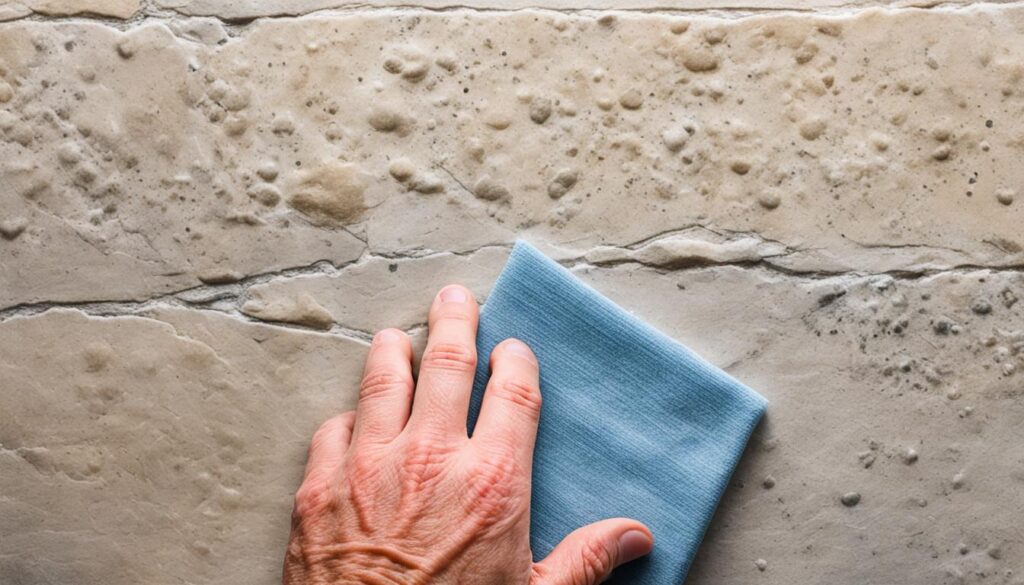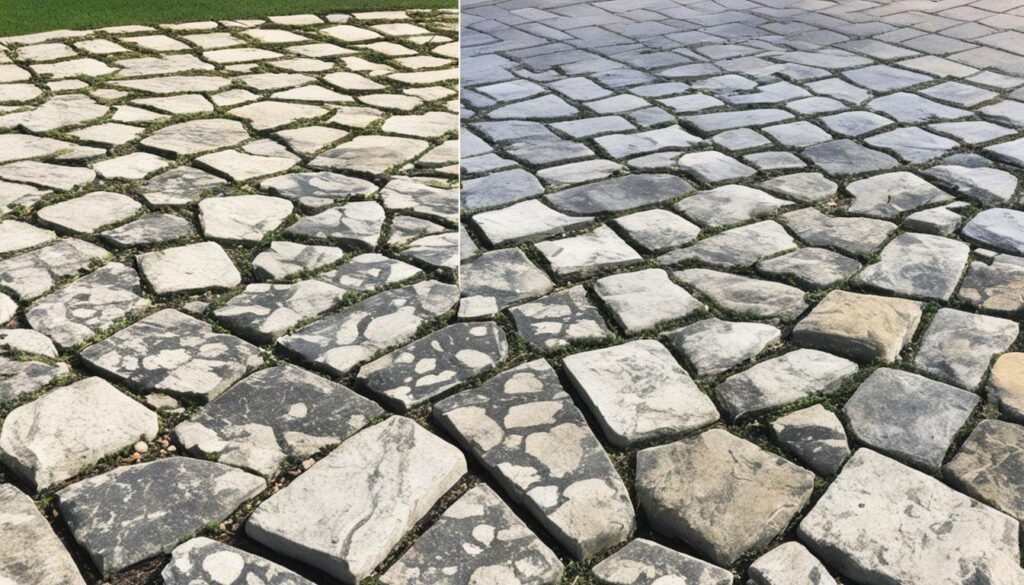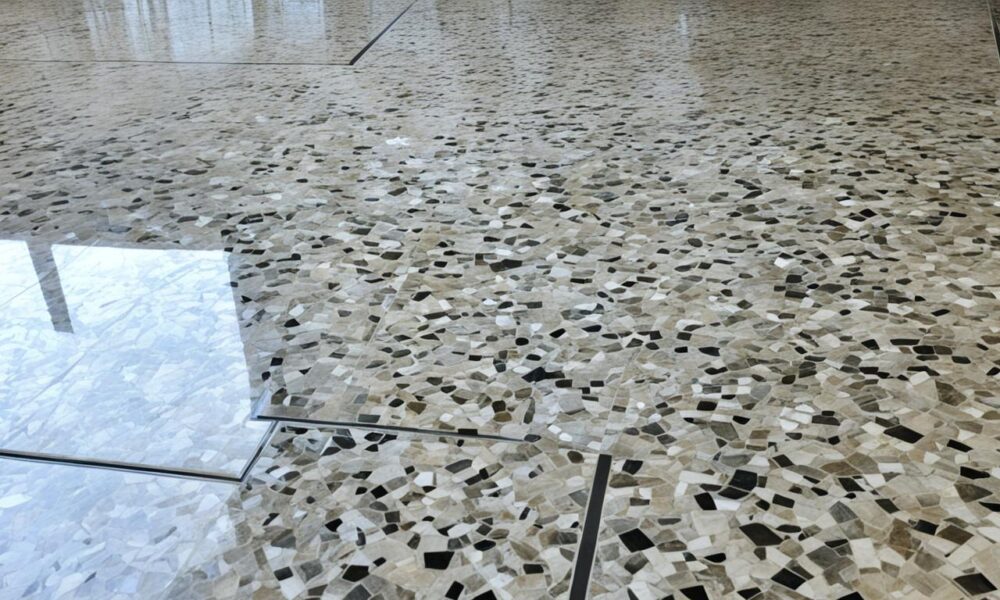Why Regular Natural Stone Maintenance Matters
Natural stone tiles are known for their beauty and long life. They need regular care to keep looking great. From marble to granite, each stone type has its own needs. Keeping them clean, sealed, and restored is key to their lasting beauty.
Not taking care of natural stone can cause problems like stains and dullness. Marble is soft and can be damaged by acidic things and daily wear. Granite is tough but still needs regular cleaning and sealing to stay shiny and stain-resistant. Limestone and travertine need careful attention to avoid moisture damage and keep their beauty.
Regular maintenance of natural stone makes it look better and last longer. Using the right cleaning methods and products helps keep your stone looking new. It also makes your home healthier by reducing allergens and bacteria.
Key Takeaways
- Natural stone tiles need regular care to stay beautiful and durable.
- Sealing, cleaning, and restoring stone are important for its care.
- Not caring for stone can cause stains, etching, and dullness.
- Good maintenance makes stone last longer and protects your investment.
- Well-kept stone surfaces are healthier for living spaces.
The Timeless Beauty of Natural Stone
Natural stone has been a favorite for centuries. It’s known for its beauty, strength, and versatility. From ancient temples to modern homes, it continues to amaze and inspire us. Each piece of natural stone is unique, offering a wide range of colors, patterns, and textures.
Natural stone comes in many types, each with its own charm. Whether you like the classic look of marble, the strength of granite, or the subtle beauty of limestone, there’s a stone for you. These stones add beauty and character to any space.
Marble: Elegance Personified
Marble tiles are famous for their elegance and luxury. They have a soft, porous nature with beautiful veining. This makes any space look sophisticated. Marble comes in many colors, from white Carrara to warm Crema Marfil, perfect for bathrooms and floors.
Granite: Unyielding Strength and Versatility
Granite tiles are known for their toughness and versatility. They’re great for busy areas like kitchens and floors because they’re hard and scratch-resistant. Granite comes in many colors and patterns, from black to reds and greens. It suits modern or traditional designs, offering strength and style.
Limestone: Understated Charm
Limestone tiles add a soft, natural beauty to spaces with their neutral colors and texture. They fit many design styles, from rustic to modern. Limestone’s colors, from beige to gray, make spaces warm and inviting. It’s perfect for flooring, walls, or accents, adding timeless elegance.
“Natural stone has a timeless beauty that transcends trends and styles. Each piece is a unique work of art, with its own character and charm.”
Natural stone is not just beautiful; it’s also durable. With the right care, it can last for generations. Choosing natural stone means enhancing your space’s beauty and creating a legacy that will be enjoyed for years.
The Importance of Regular Natural Stone Maintenance
Natural stone is a timeless and stunning choice for any space. Its beauty and longevity depend on proper care and maintenance. Regular stone maintenance is key to keeping your natural stone surfaces looking great.
Without consistent upkeep, even the most durable stones can lose their shine, get stained, and deteriorate. This is why taking care of your stone is so important.
Preserving the Luster and Aesthetic Appeal
Regular stone maintenance helps keep your natural stone surfaces looking beautiful. Each stone type has its own unique look, from marble’s elegant veining to granite’s rich depth. With the right care, these features stay vibrant and stunning for years.
Natural stone is durable and can handle harsh weather, heavy foot traffic, and environmental stresses. But, it still needs regular maintenance to stay looking great. If you don’t take care of it, your stone can look dull and detract from your space’s beauty.
Protecting Your Investment
Investing in natural stone boosts your property’s look and value. It adds curb appeal and creates a luxurious feel. But, not taking care of it can lead to expensive repairs and damage that can’t be fixed.
Regular professional maintenance protects stone from erosion, staining, and dulling. This is crucial in places like Houston, where the humid climate can harm your stone. By trusting experts like Modern Stone Care, you ensure your stone is well-protected with the latest techniques and products.
| Stone Type | Maintenance Benefit |
|---|---|
| Marble | Preserves elegant veining and prevents etching |
| Granite | Maintains rich color and resists staining |
| Limestone | Protects against weathering and discoloration |
| Travertine | Prevents moisture damage and enhances durability |
In conclusion, regular natural stone maintenance is vital for enjoying these beautiful surfaces. It helps preserve the luster and protects your investment. Trust Modern Stone Care to give your natural stone the care it deserves.
Benefits of Consistent Stone Care
Regular maintenance of your natural stone surfaces has many benefits. It keeps your investment looking great, working well, and holding its value. By caring for your stone regularly, you make sure it stays beautiful and useful for many years.
Enhancing Longevity and Durability
Regular stone care makes it last longer and stay strong. Stones like granite, marble, and limestone are strong but can wear down if not cared for. A good maintenance plan helps reduce daily wear and tear.
Cleaning, sealing, and polishing your stone keeps it in top shape. This stops cracks and chips before they start. Keeping up with care means your stone looks new and impresses everyone for years.
Maintaining Hygiene and Health
Stone care is key for keeping your space clean and healthy. Natural stone can hide harmful germs if not cleaned right. Regular cleaning gets rid of these germs, making your space safer for everyone.
Also, a clean stone surface doesn’t get mold or mildew, which is good for people with breathing problems. Taking care of your stone means a cleaner, healthier place for everyone.
Preventing Stains and Blemishes
Stains can ruin the look of natural stone. But regular care cuts down on stains and discoloration. Cleaning spills fast and using sealants helps protect your stone from liquids.
Quick action on stains stops them from setting in. This keeps your stone looking great and saves you from expensive fixes later. With regular care, your stone stays beautiful and stain-free.
Regular stone maintenance is more than making it look good. It’s about keeping your stone strong, clean, and beautiful. A consistent care routine lets you enjoy your stone for years.
| Stone Type | Recommended Sealing Frequency | Benefits of Regular Sealing |
|---|---|---|
| Granite | Once or twice a year | Prevents staining and enhances durability |
| Marble | Every 3-6 months | Protects against etching and staining |
| Limestone | Every 6-12 months | Minimizes water absorption and staining |
| Travertine | Every 1-2 years | Maintains color and prevents staining |
Essential Maintenance Practices
To keep natural stone looking great and lasting long, you need to clean it regularly and manage spills well. By following these key maintenance steps, your natural stone will stay beautiful and strong for many years.
Regular Cleaning Techniques
Cleaning your natural stone often and gently is key to keeping its shine and cleanliness. Start by sweeping or dust mopping to get rid of loose dirt and debris. This prevents scratches. For a deeper clean, use a cleaner made just for natural stone that’s pH-neutral. Acidic or alkaline cleaners can harm the stone.
Wipe or mop the surface with a soft cloth or mop, but don’t soak the stone. Don’t use harsh tools or too much cleaner, as they can wear down the stone’s finish. For outdoor stone, pressure washing is okay if done right to avoid harming the stone and grout.
Dealing with Spills and Stains
Natural stone can stain easily from things like wine, coffee, or citrus. Quick action is the best way to stop stains. Blot spills with a clean cloth to soak up as much liquid as you can. Don’t wipe the spill, as it can spread the stain deeper into the stone.
For tough stains, try a poultice or a stone stain remover, following the directions carefully. Always test any new cleaner on a small area first to make sure it won’t damage the stone.
| Stain Type | Removal Technique |
|---|---|
| Oil-based (grease, cooking oil, cosmetics) | Clean with a mild, pH-neutral dish soap or stone cleaner, then rinse thoroughly. |
| Organic (coffee, tea, fruit, tobacco) | Clean with a 12% hydrogen peroxide solution, then rinse thoroughly. |
| Ink (magic marker, pen, ink) | Clean with bleach or hydrogen peroxide, then rinse thoroughly. Do not use on dark stone. |
| Water spots and rings | Buff with dry 0000 steel wool. |
Preventing stains is better than fixing them. Use coasters under glasses, mats under dishes, and clean spills right away to lower the chance of stains. With regular cleaning and quick action on spills, your natural stone will stay perfect for years.
The Role of Sealing in Stone Protection
Sealing your natural stone surfaces is key to keeping them looking great and lasting long. Stone sealants create a barrier that stops stains, etching, and bacteria, keeping the stone beautiful for years. It’s vital for protecting marble countertops, limestone floors, and granite outdoor features with a top-notch stone sealer.
Different stones need sealing at different times. Stones like marble, limestone, and onyx should be sealed every six months. But granite and quartz only need sealing once a year to stay protected.
Choosing the right stone sealant is crucial. Think about your stone’s type and where it’s used. There are three main types of sealants:
- Surface sealants: These create a protective layer on the stone’s surface, making it resistant to stains and etching.
- Penetrating sealants: These go deep into the stone’s pores, offering long-lasting protection against moisture and stains.
- Combination sealants: These combine the benefits of surface and penetrating sealants for full protection.
Stone sealers stop water and oil from getting into the stone’s pores, protecting the surface. But remember, no sealer can stop all damage. You still need to use coasters, clean spills quickly, and avoid acidic substances to keep the stone looking new.
Sealing natural stone is a regular task. You might need to do it every six months or once every one to three years, depending on the stone and where it’s used.
To get the best protection for your stone, talk to your stone supplier or a pro to pick the right sealer and how often to reseal. Regular sealing and care will help your natural stone stay beautiful and strong for many years.
Addressing Common Stone Issues
Natural stone is a top choice for flooring and countertops because it’s durable and looks great. But, it can face damage. Etching and scratches are two common problems. Keeping the grout in good shape is also key to maintaining your stone’s beauty. Let’s dive into these issues and see how to prevent and fix them.
Preventing Etching and Scratches
Etching happens when acids touch the stone, making it dull or rough. To stop etching, clean spills right away, especially from things like citrus fruits or wine. Using coasters and placemats can also protect your stone.
Scratches come from a lot of foot traffic, moving furniture, or sharp things touching the stone. To lessen scratches, put area rugs or mats in busy spots and use felt pads under furniture. Be careful when moving heavy things and avoid dragging them to prevent scratches.

If your stone gets etched or scratched, you can get it fixed by professionals. They might polish, hone, or resurface it to make it look new again.
Managing Grout Problems
Grout fills the spaces between stone tiles and is key to your stone’s look and function. Over time, grout can stain, crack, or change color, making your stone look bad.
To keep your grout looking good, clean it often. Use a cleaner that’s pH-neutral and a soft brush to get rid of dirt. For tough stains, you might need a special grout cleaner. But, avoid cleaners that are too harsh or acidic because they can harm the grout and stone.
If your grout is cracked or crumbling, you might need to fix or replace it. This means taking out the bad grout, cleaning the area, and putting in new grout. If you’re not sure how to do this, it’s best to hire a pro for the job.
Proper stone etching prevention, scratch prevention, and grout maintenance can help keep your natural stone surfaces looking beautiful for years to come.
| Issue | Prevention | Solution |
|---|---|---|
| Etching | Clean spills immediately, use coasters and placemats | Professional restoration (polishing, honing, resurfacing) |
| Scratches | Use area rugs, felt pads under furniture, avoid dragging heavy objects | Professional restoration (polishing, honing, resurfacing) |
| Grout Problems | Regular cleaning with pH-neutral cleaner, avoid harsh or acidic cleaners | Repair or replace damaged grout |
Stone-Specific Care Tips
Each type of natural stone has its own needs to stay beautiful and strong. Knowing how to care for marble, granite, limestone, and travertine is key. This will help your stone surfaces look great for many years.
Marble Maintenance Secrets
Marble is known for its beauty and classic look. But, it’s a bit soft and can stain easily. To keep your marble looking good, follow these tips:
- Clean marble surfaces with a pH-neutral cleaner made for natural stone.
- Don’t use acidic cleaners, as they can make the marble dull.
- Seal marble every 6-12 months to protect it from stains and damage.
- Quickly wipe up spills to stop them from getting into the stone.
- Use coasters and placemats under glasses and dishes to avoid scratches.
Granite Upkeep Strategies
Granite is tough and can handle scratches, stains, and heat well. It’s not as porous as marble, but sealing it helps with stains. Here are some tips for keeping granite in top shape:
- Clean granite with a mild, pH-neutral cleaner and a soft cloth or sponge.
- Don’t use abrasive cleaners or scrubbers that can scratch the granite.
- Seal granite every 1-2 years to keep it stain-resistant.
- Use trivets or hot pads under hot dishes to prevent damage.
- Clean spills right away to stop stains.
Limestone and Travertine Care
Limestone and travertine are lovely stones but need special care. They’re porous, so sealing them helps protect against moisture and stains. Here are some tips for limestone and travertine:
- Clean these stones with a mild, pH-neutral cleaner made for natural stone.
- Avoid acidic cleaners, as they can damage the stone’s surface.
- Seal them every 6-12 months to protect against stains and moisture.
- Wipe up spills quickly to prevent damage.
- Use doormats or area rugs in busy areas to keep dirt away.
By following these care tips and the manufacturer’s advice, you can keep your marble, granite, limestone, and travertine looking great.
DIY vs. Professional Stone Maintenance
When it comes to keeping your natural stone surfaces looking great, you have two choices: do it yourself or hire a pro. DIY can save money and be easy, but sometimes you need a pro’s help.
For everyday cleaning and sealing, DIY works well. With the right tools and some effort, you can keep your stone in top shape. But for tough stains, scratches, or big restoration jobs, you should call a pro.
Professional stone restoration services, such as Prestige Grout, Marble & Granite Restoration in Chicago, focus on honing, polishing, and sealing natural stone to restore its luster and protect it from future damage.
Professional care might cost more upfront, but it can save you money over time. It can also prevent expensive repairs later. Plus, pros have the right machines and cleaners for better results than DIY.
| DIY Stone Maintenance | Professional Stone Care |
|---|---|
| Lower initial cost | Higher upfront cost, but may save money long-term |
| No ongoing fees once you have supplies | Regular professional cleaning adds up over time |
| Suitable for regular cleaning and sealing | Best for deep cleaning, stubborn stains, and restoration |
| Requires regular investment in supplies and tools | Uses industrial-grade machines for superior results |
Think about these points when choosing between DIY and professional care:
- The severity of the issue at hand (e.g., deep stains, scratches, or etching)
- Your level of experience and comfort with DIY techniques
- The amount of time you can dedicate to maintaining your stone surfaces
- Your budget for stone care and restoration
Often, a mix of DIY for everyday care and professional help for tough problems works best. This way, your natural stone surfaces will look great for many years.
Frequently Asked Questions about Stone Care
Homeowners often wonder how to keep their natural stone looking great. We’ll answer some common questions to help you care for your stone right.

Many ask how often to seal natural stone. The answer varies by stone type and color. Dark granite needs sealing every other year, while light granite should be sealed yearly. White marble and similar stones like limestone or travertine should get sealed twice yearly. A good sealer like HMK® S234 protects against stains on all stones.
People also ask about the best cleaners for natural stone. It’s key to use cleaners made just for stone, like StonePro’s Crystal Clean. Wrong cleaners can damage the stone. Crystal Clean Spray is safe for daily use and great for cleaning around food areas.
Getting rid of tough stains is a big worry for many. For rust stains on granite, use acid-based cleaners like R777 Rust Remover. For stains from drinks like coffee or wine on granite countertops, Wet Poultice Stain Remover works well.
Stains and etch marks are different; stains change the stone’s color, while etch marks make it look white or dull.
Some wonder about the upkeep of different stones. All natural stones need sealing to protect against stains and damage. But, some stones like granite with lots of swirls or veins are more prone to staining.
| Stone Type | Recommended Sealing Frequency |
|---|---|
| Dark Colored Granite | Once every other year |
| Light Colored Granite | Once a year |
| White Marble, Limestone, Travertine | Twice a year |
By answering these stone care questions, homeowners can better care for their natural stone. This way, they can keep their stone looking beautiful.
The Environmental Benefits of Natural Stone
In today’s world, choosing sustainable and eco-friendly options is key. Natural stone is a great choice for flooring and other uses. It brings beauty and character to any space and helps the planet. Let’s look at how natural stone is good for the environment and how to keep it green.
A Sustainable Flooring Choice
Natural stone is a top pick for eco-friendly flooring. It’s a natural resource that doesn’t harm the environment much when taken from quarries. Making stone requires less energy than synthetic materials, so it has a lower carbon footprint. Plus, it helps control the temperature inside buildings, which can save money.
Stone is also very durable. With the right care, it can last for many years. This means less waste and saving money on repairs and replacements compared to other floors.
Reducing Carbon Footprint with Proper Maintenance
Looking after your stone floor is key to making it last longer and be kinder to the planet. By cleaning and sealing it regularly, you keep its beauty and strength. This means you won’t need to replace it as often, which cuts down on waste and the carbon emissions from making new materials.
Companies like Polycor offer environmental product declarations (EPDs) to help pick materials wisely. By choosing stone from sustainable sources and certified quarries, architects and homeowners can lower their building’s carbon footprint.
| Material | Embodied Carbon (kg CO2e/m2) |
|---|---|
| Natural Stone | 28 |
| Ceramic Tile | 55 |
| Porcelain Tile | 74 |
| Hardwood | 21 |
| Carpet | 37 |
The table shows how natural stone beats other flooring in being eco-friendly. By picking natural stone and taking good care of it, homeowners can help the planet. They won’t have to give up style or durability.
In conclusion, natural stone is a green choice for flooring. It’s sustainable, lasts a long time, and can cut down on carbon emissions with the right care. It’s perfect for those wanting a beautiful, lasting, and earth-friendly space.
Conclusion
The beauty of natural stone shows its lasting charm and flexibility. Whether you picked marble, granite, or limestone, your stone surfaces are a big deal. They need the right care to keep looking great and staying strong.
Regular natural stone maintenance is key. It helps your tiles stay shiny, tough, and clean. Simple steps like cleaning up spills fast, using pH-neutral cleaners, and sealing your stone help a lot.
Using coasters, placemats, and the right cleaning tools also helps. These steps protect your stone from scratches and stains. By taking care of your stone, you save money and help the planet too.
Looking after your natural stone is a smart move. It’s a material that lasts a long time with the right care. Every effort you put into keeping it clean and safe is a step towards keeping its beauty for years to come.



